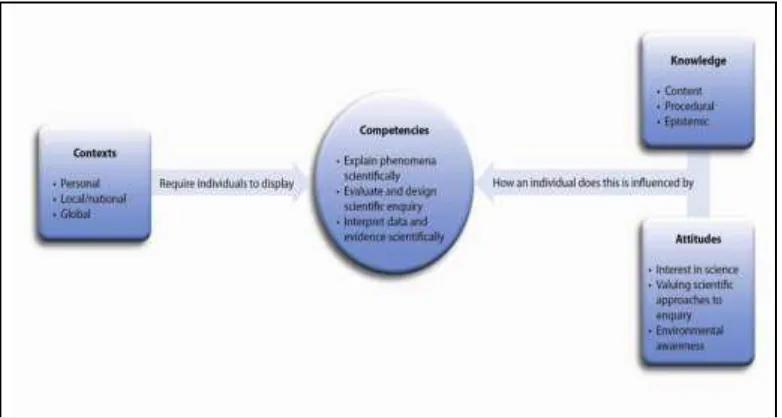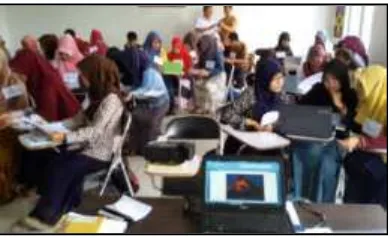OCE-02
Designing a Learning Environment of Science Education
Based on PISA for Student and Teachers: Chemistry
Content
Hartono
1*, Effendi
1, Rahmi Susanti
1, Riyanto
1, Ismet
1, Sardianto Markos
Siahaan
1, Zulkardi
1, Ratu Ilma Indra Putri
1, Maarten Dolk
2, Harrie Eijkelhof
2*1*Sriwijaya University, FKIP Kampus Unsri Indralaya, Indonesia, [email protected] 2
Utrecht University, Domplein 29, 3512 JE Utrecht, Netherlands
Abstract-This research aimed to produce designed learning environment of chemistry content based on PISA framework at the secondary school level to support student and teacher in science learning. Development research was chosen to achieve the aims of the research. The research involved forty-two students of first semester Physics Education Program who took Basic Chemistry course. The result of teaching showed that learning environment can stimulate students to establish high reasoning to solve problem. Based on both observation and evaluation process during learning, the students have high activities namely (1) to raise hands to explain of their work results in front of class, (2) to engage in class discussion and have good communication skills, (3) to learn for hearing and analyzing of student explanation, and (4) to learn for changing both concepts and ways in learning science.
Keywords: development research, Basic Chemistry, PISA
1. Introduction
In 2012 Indonesian PISA rank for science was 64 from 65 countries referred as Web 1. Education acheivement in the world can rise national competiveness globally, in other hand, 20% for education budget. The PISA rank gives reflection toward teaching and learning process especially in evaluation process. Both teachers and students should be introduced to PISA modelitem test. Reading scientific literacy and scientific argumentation are important. Several studies have been done related PISA such as Tai (2014) stated that using online environment of teaching and learning process that facilitate their students to complement argumentation instruction and organizing argumentation activities focussed on related topics may be potential direction to
consider for improving students‘ PISA scientific competencies. Futhermore, Lavonen and Laaksonen (2009) concluded that in Finland, teacher demontration, practical work and posibility for student to draw conclusions gave good factors to increase high results for PISA science performance. It meas thatteaching modelswhich arebased on experiences and studies that were conducted in successed country for PISA may be implemented in Indonesian schools context.
A learning environment is an important thing for students. The learning environment refers to condition where students can engaging. Stimulating, and enriching learning environment to grow and thrive. In order to achieve this type of rich environemnt, effective teachers establish and communicate guidelines for expected behavior, monitor students behavior, keep students on task, and infuse humor, care, and respect into the classrom interactions, so as to develop a climate that is conducive to students learning. As a result, research has indicated that a positive learning environment can shape students outcomes in cognitive, motivational, emotional, and behavioral domains.
2. Method
The research used development research to create a learning environment by several activities such as analyze, design and produce teaching materials, and evaluation. On the First stage, several analyses were conducted at national item tests, framework of PISA, and sillaby of general chemistry. The Second stage is designing the test by modifying PISA item tests and ajusting them with Indonesian contexts. Futhermore, teaching materials were such as student worsheets and PISA like item tests are produced. Finally, there were stages of evaluation as self evaluation, expert review, one to one test, small group test, and field test. The research was conducted in odd semester 2014/2015 and involved first semester students who took general chemistry in Physics Program Study both in Palembang and Indralaya classes.
3. Result and Discussion
Analysis of national item tests for secondary school, PISA item test, and sillaby were done. First, basically national item tests for secondary school is different with PISA test. The national item tests focusses on whether students understand, implement, and use the concepts. Unlike PISA tests, students challenge to understand phenomenon and get problems from those then give solutions in order to answer the problem using certain concepts. Second, framework PISA is important to learn the relationship to introduce PISA to students. As figure 1 bellow, science framework of PISA 2015 showed that competencies are central of framework which indicate that 15 years old students should be able to explain, evaluate/design, and interpret regarding phenomena, do scientific enquiry, and analyze data and evidence scientifically. In relation to the competencies, contest, knowledge and attitudes are needed integrately to enhance students understanding science in general. Third, Sillaby of general chemisry for Physics Program Study has been revised for 1 through 3meeting. The meetings were modified on contexts, worksheets, item tests, and learning processes to fasilitate students PISA based learning.
Figure 1. PISA Science Framework 2015 (Referred as Web 2)
Designing learning environment and producing teaching materials involved in biology, physics and chemistry education field faculty members team. Learning environment were designedtochalange the students to come up with their argumentation/reasoning. A lecturer began lesson with a phenomena in scientific literacy and asked students to raise questions/responds.
Futermore, students in small groups discussed to solve problems at students‘ worksheet and each
First, the research built a learning environment beginning with a model of teaching that fasilitates students and teachers to solve problems with own their thinking (Zulkardi et al., 2014). Stages of learning include (1) orientate toward problems/topics, (2) organize students, (3) guide to investigate, (4) develop results and presentate, and (5) analyze and evaluate processess. Lang and Evans (2006) stated that problem based learning is any learning situastion in which the problem drives the learning. Students discover that they need the information or skills to solve a problems. The states are relevant with the research that began the learning with orientation toward the scientific problems.
Second, the research developed Indonesian context teaching. The problem is designed to be similar with PISA item tests such as;
RING OF FIRE
Figure 2. The Volcano
Indonesia is an archipelago located in the Pacific rings of fire, therefore, active volcanoes are still found, one of which is Mount Sinabung. Sinabung eruptions caused buildingsdamage, while larvae and volcanic ash impact on the lives of plants and animals that live in the surrounding area. Phenomenon that could be found from the eruption of Mount Sinabung include crop yields declined or failed crops, dying animals and plants, less oxygen availability so people around need to use a mask, poisoning gases that are emitted by the mountain and and acidrain. Problem:
Volcanic earthquakes were accompanied by rain, rain water is usually acidic. Explain why it could be happen!
Students tried to solve the problems in small groups with their own thinking and also to colect data from several resources as gadgets, computers with internet connection, and books as well. The student activities were shown by Figure 3 bellow. They discussed problems and the solutions in a worksheet. These learning environment gave students awareness toward classroom environment so they could learn democracy in group and value of respecting each other.
Student presentation was an important thing from the learning environment (Figure 4). A little debate was occured while the group presentated their work results. The group in charge for presentation explained their work in front of classroom. They compared their own result each others and the result might be different things. So, lecturer rolein the discussion was important to
decide whether student answered right or mistake. Example of students‘ answer was ―the presence of water vapor contained in around mountains would react with gas of sulfur dioxide then produced sulfurous acid and sulfuric acid that soluted in rain water‖. Several groups debated with the products. The student presentation would make class to be active in terms of raising hands to answer questions and making argumentation. Beside that, almost all the students are involved the class and learn by showingtheir communication skill. They bravelydelivered their work to the class.
Figure 4. Class Discussion
Other students learn how to be a good listener. At the end of learning, the students changed their concepts if they were in wrong concept. The lecturer gave final conclusions. So, They knew whether their concept right or wrong. The way of science learning have been practised and experienced science is positively different and hopely they will teach science by the same way in the future.
4. Conclusion
Designing of a learning environment have been done by implementing model of problem based learning at general chemistry course on Undergratuate of Physics Education Program both in Indralaya and Palembang classes. The product of a learning environment was not only model of
problem based learning but also students‘ worksheet. The learning environment was able to enhance students learning processes and also introduce PISA like item test with Indonesian context to student-teacher.
Acknowledgements
The funding research here was supported by Faculty of Teacher Training and Education Sriwijaya University under grant international collaboration research. The author also greatly appreciates Prof. Harrie Eijkelhof who gave avaluable suggestions of PISA item tests and journal resources.
References
Lang, HR & Evans DN. (2006). Models, Strategies and Methods for Effective Teaching. Boston: Pearson Education. Inc.
Lavonen, J. & Laaksonen, S. (2009). Context of Teaching and Learning School Science in Finland: Reflection on PISA 2006 Results. Journal of Research in Science Teaching, 49(8): 922--944.
Tsai, Chun-Yen.(2014). Improving Students‘ PISA Scientific Competencies Through On Online Argumentation. International Journal of Science Education, 37(2): 1—19.
Zulkardi, Putri, RII, Hartono, Susanti, R., Riyanto, Siahaan, SM, Nawawi E., and Ismet. (2014). Designing a Learning Environment on Mathematics and Science Education Based on PISA for Indonesian Student-Teacher. Research Report. Indralaya: FKIP Sriwijaya University.
Web 1: http://www.kompasiana.com/siswa-indonesia-peringkat-64-dari-65-negaratapi-paling- bahagia-di-dunia consulted 5Dec. 2013.
Web 2:

